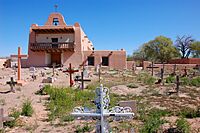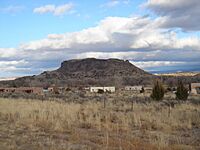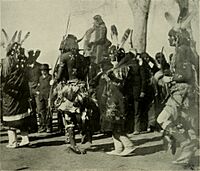San Ildefonso Pueblo, New Mexico facts for kids
| Pʼohwhogeh Ówîngeh | |
|---|---|
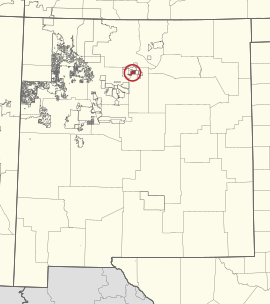
Location of San Ildefonso Pueblo
|
|
| Total population | |
| 750 | |
| Regions with significant populations | |
| Languages | |
| Tewa, English | |
| Related ethnic groups | |
| Tewa |
|
San Ildefonso Pueblo, New Mexico
|
|
|---|---|
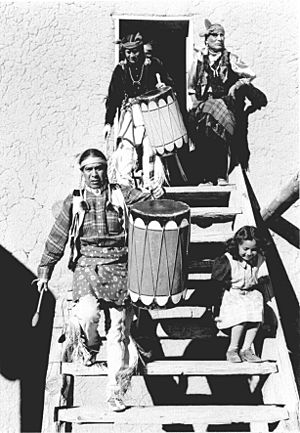
Drummers at San Ildefonso Pueblo, 1942. Ansel Adams, photographer
|
|
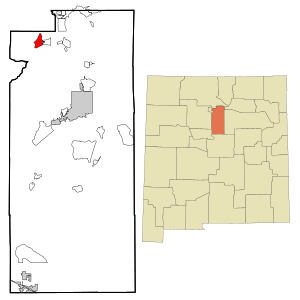
Location of San Ildefonso Pueblo, New Mexico
|
|
| Country | |
| State | |
| County | Santa Fe |
| Area | |
| • Total | 4.61 sq mi (11.94 km2) |
| • Land | 4.42 sq mi (11.44 km2) |
| • Water | 0.20 sq mi (0.50 km2) |
| Elevation | 5,528 ft (1,685 m) |
| Population
(2020)
|
|
| • Total | 624 |
| • Density | 141.27/sq mi (54.55/km2) |
| Time zone | UTC-7 (Mountain (MST)) |
| • Summer (DST) | UTC-6 (MDT) |
| ZIP code |
87501
|
| Area code(s) | 505 |
| FIPS code | 35-68010 |
| GNIS feature ID | 2409256 |
| Website | |
|
San Ildefonso Pueblo
|
|
| Lua error in Module:Location_map at line 420: attempt to index field 'wikibase' (a nil value). | |
| Nearest city | Espanola, New Mexico |
| Area | 46.8 acres (18.9 ha) |
| Built | 1591 |
| NRHP reference No. | 74001206 |
| Significant dates | |
| Added to NRHP | June 20, 1974 |
San Ildefonso Pueblo is a special place in New Mexico, United States. Its name in the Tewa language is Pʼohwhogeh Ówîngeh, which means "where the water cuts through." This community is a federally recognized tribe and was started around the year 1300.
The Pueblo is self-governing, meaning its people make their own rules. It is part of the larger Santa Fe area. As of 2020, about 624 people live there. San Ildefonso Pueblo is one of the Eight Northern Pueblos. The people who live here are from the Tewa ethnic group of Native Americans. They speak the Tewa language.
Contents
Geography of San Ildefonso Pueblo
San Ildefonso Pueblo is located in Santa Fe County. It covers about 4.6 square miles (11.9 square kilometers). Most of this area is land, with a small part being water.
The Pueblo sits at the base of a large hill called Black Mesa. This location has been important throughout its history.
People of San Ildefonso Pueblo
In 2010, there were 524 people living in the San Ildefonso area. Most residents, about 62%, were Native American. Other groups included White people and people of two or more races. About 32% of the population was Hispanic or Latino.
Many households had children under 18 living with them. The population included people of all ages, from young children to seniors.
| Historical population | |||
|---|---|---|---|
| Census | Pop. | %± | |
| 2010 | 524 | — | |
| 2020 | 624 | 19.1% | |
| U.S. Decennial Census | |||
History of San Ildefonso Pueblo
Early Beginnings
The Pueblo was founded around 1300 A.D. The first people came from the Mesa Verde area in Southern Colorado. They moved through a place called Bandelier, where they built homes from soft volcanic rock.
After a long time without much rain, they moved to the Rio Grande valleys around 1300 C.E. The Rio Grande and other streams provided water for farming.
Spanish Arrival and Pueblo Revolt
In the early 1600s, Spanish explorers and settlers arrived. They tried to control the native people and introduce Catholicism. This led to the Pueblo Revolt in 1680.
During the revolt, the people of San Ildefonso found safety by climbing to the top of Black Mesa. The Spanish eventually ended the siege. After this, the native people gained more freedom for their religion and some self-governing rights.
Land and Population Changes
Spanish settlers sometimes took land from the Pueblo. By the 1760s, some families had no land to grow food. In 1786, Governor Juan Bautista de Anza helped restore some of their lands.
Mexico took control of the area in 1821. Then, the United States gained control in 1848 after the Treaty of Guadalupe Hidalgo. In 1858, the U.S. Congress officially set aside 17,292 acres of land for the Pueblo. This land grant was confirmed in 1864.
By 1864, only 161 Pueblo members remained. A smallpox outbreak in 1918 reduced the population to less than 100 people.
Modern Economy and Art
For a long time, the people of San Ildefonso relied on farming. In the early 1900s, Maria Martinez and her husband Julian Martinez rediscovered how to make special Black-on-Black pottery. This pottery became very famous.
Since then, the Pueblo has become more focused on tourism. Many shops sell local crafts. Because it is close to Santa Fe and the Los Alamos National Laboratory, many residents also work for the state or federal government.
Economic Development
The San Ildefonso Pueblo Enterprise Corporation (SIPEC) helps the Pueblo grow its economy. It works with companies and people who want to use the Pueblo's location to create jobs and economic growth for the community.
Education
Children in San Ildefonso Pueblo attend schools run by Pojoaque Valley Public Schools. The main high school for the area is Pojoaque Valley High School.
The Bureau of Indian Education also runs an elementary school in the Pueblo called San Ildefonso Day School.
Culture and Traditions
The people of San Ildefonso are proud of their identity. They continue to practice ancient ceremonies, rituals, and tribal dances. Many of these traditions are kept private.
However, some events are open to the public. The San Ildefonso Feast Day is celebrated every January 23. Other public dances include the Corn Dance in September and dances around Easter.
San Ildefonso Art
There was an important art movement called the San Ildefonso Self-Taught Group. This group included famous artists like Alfonso Roybal, Tonita Peña, Julian Martinez, Abel Sanchez, Crecencio Martinez, and Jose Encarnacion Peña. They created beautiful artworks, especially watercolors.
Notable People from San Ildefonso Pueblo
Many talented people have come from San Ildefonso Pueblo:
- Alfred Aguilar (born 1933), a painter and ceramic artist.
- José Angela "Joe" Aguilar (born 1898), a potter and painter.
- José Vicente Aguilar (born 1924), a painter.
- Clara Archilta (1912–1994), known for her watercolor paintings and beadwork.
- Gilbert Benjamin Atencio (1930–1995), a painter.
- Awa Tsireh (1898–1955), also known as Alfonso Roybal, a watercolor artist.
- Crucita Calabaza (1921–1999), also known as Blue Corn, a famous pottery artist.
- Joe Herrera (1923–2001), a painter.
- Edgar Lee Hewett (1865–1946), an anthropologist who helped the San Ildefonso Self-Taught Group.
- Manuel Lujan (1928–2019), who served in the U.S. House of Representatives and as the U.S. Secretary of Interior.
- Julian Martinez (1879–1943), a pottery artist.
- Maria Martinez (1887–1980), a very famous pottery artist.
- Jose Encarnacion Peña (1902–1979), a painter.
- Tonita Peña (1893–1949), a watercolor artist.
- Oqwa Pi (1899–1971), also known as Abel Sanchez, a painter and muralist.
- Josefa Roybal, a painter and potter.
- Martina Vigil-Montoya (1856–1916), a ceramics painter.
Gallery
See also
 In Spanish: San Ildefonso Pueblo para niños
In Spanish: San Ildefonso Pueblo para niños




